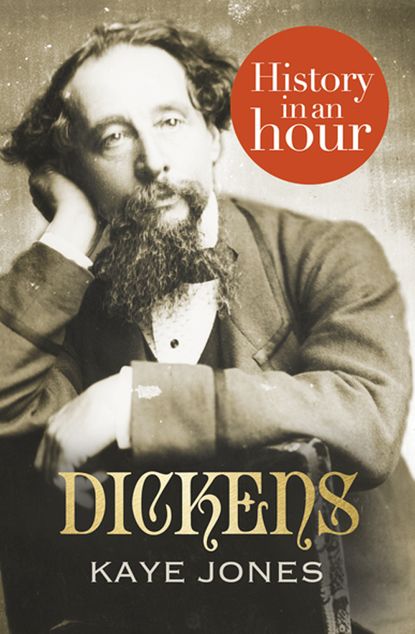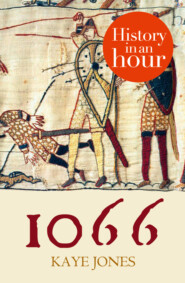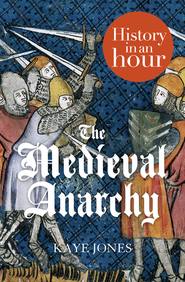По всем вопросам обращайтесь на: info@litportal.ru
(©) 2003-2024.
✖
Dickens: History in an Hour
Настройки чтения
Размер шрифта
Высота строк
Поля
Dickens: History in an Hour
Kaye Jones
Love history? Know your stuff with History in an Hour.Charles Dickens remains – 200 years after his birth – arguably Britain’s most successful writer. Works such as Great Expectations and Oliver Twist have amused and inspired readers in all languages since their original publication in the nineteenth century, and have been adapted countless times for the stage and screen.Dickens: History in an Hour covers all the major facts and events surrounding Dickens’s life; the poverty of his childhood, his experience in Warren’s Blacking Factory, the evolution of his novels, his tours around America and Europe and his sometimes scandalous private life. Dickens: History in an Hour tells you everything you need to know about Charles Dickens in just one hour.Know your stuff: read about Dickens in just one hour.
DICKENS
History in an Hour
Kaye Jones
About History in an Hour (#u6cedcbb5-e3fe-5e51-ad41-632bcf488d92)
History in an Hour is a series of ebooks to help the reader learn the basic facts of a given subject area. Everything you need to know is presented in a straightforward narrative and in chronological order. No embedded links to divert your attention, nor a daunting book of 600 pages with a 35-page introduction. Just straight in, to the point, sixty minutes, done. Then, having absorbed the basics, you may feel inspired to explore further.
Give yourself sixty minutes and see what you can learn . . .
To find out more visit http://historyinanhour.com or follow us on twitter: http://twitter.com/historyinanhour
Contents
Cover (#ud5b44447-a238-5f9f-a903-37a2a310e5e3)
Title Page (#uca1853aa-d720-56b3-aef4-5e179f3e7fa4)
About History in an Hour
Introduction
The Early Years
London
Miss Maria Beadnell
The Creation of ‘Boz’
The Early Novels
The 1840s
Dickens in America
Dickens in Europe
Dickens the Philanthropist
Return to Journalism
Dickens the Reformer
Dickens’ Private Life
Dickens the Public Reader
The Later Years
Appendix 1: Key Figures
Appendix 2: Timeline of Dickens
Copyright
Got Another Hour?
About the Publisher (#litres_trial_promo)
Introduction (#u6cedcbb5-e3fe-5e51-ad41-632bcf488d92)
One of the most celebrated British authors of all time, Charles John Huffam Dickens was born on 7 February 1812 in Portsmouth England. Though Dickens received little formal education, he produced some of the most famous works of the Victorian era, such as Oliver Twist and A Christmas Carol, novels that continue to be enjoyed today. Dickens did not limit himself to being a novelist, he was also a journalist, social commentator, philanthropist, husband, lover and father.
Charles Dickens c. 1867, photograph by Jeremiah Gurney
As a celebration of the bicentenary of his birth in 2012, this ebook will guide readers through the formative events, relationships and experiences that inspired and underpinned his work.
The Early Years (#u6cedcbb5-e3fe-5e51-ad41-632bcf488d92)
Charles Dickens was born in Portsmouth on 7 February 1812. He was the second child of Elizabeth Dickens (née Barrow) and John Dickens, a clerk in the naval pay office attached to the nearby dockyard. Due to the nature of John’s work, the family moved frequently during Dickens’ earliest years, with stays in and around London, and to Sheerness, before a more permanent posting to the Chatham Dockyard in Kent in 1817. Here, the family lived at 2 Ordnance Terrace, a six-roomed house with two live-in servants.
Ordnance Terrace, Chatham, photograph by Clem Rutter
It was Elizabeth Dickens who took responsibility for the education of Dickens and his elder sister, Fanny, in these early years. Alongside her lessons in English and Latin, Dickens became an avid reader. He spent many hours in the attic enjoying the books from his father’s collection, such as Don Quixote, The Arabian Nights and Robinson Crusoe. Dickens also received some schooling at a nearby dame school. Prior to the introduction of compulsory education for children in 1870, these schools provided a much-needed service for families who were too poor to pay for private schooling. Dame schools, often run by an unqualified woman from her own home, helped many children master the basics of reading, writing and arithmetic.
In 1821 Dickens left the humble dame school and enrolled at the Reverend William Giles’ School, a private, fee-paying establishment. It was around the same time that John Dickens’ financial problems, of which the origin is unknown, caused the family to relocate to a smaller house in Chatham. Money troubles, however, did not stand in the way of a happy childhood. At school, Dickens made great progress, while at home he wiled away his time with make-believe games, performing recitals and plays with his sister, Fanny. On several occasions the pair saw plays by Shakespeare at the Rochester Playhouse, inciting in the young boy a love of the theatre that would endure throughout his life. With its majestic cathedral, ruined castle and bustling river, the city of Rochester also captured his imagination.
Somerset House, c. 1836
The next year, however, John Dickens took up a new position at Somerset House in Central London. Dickens remained in Chatham to finish the term at Giles’ School and then joined the family at 16 Bayham Street. Situated in the less genteel suburb of Camden Town, Dickens described it as having a ‘basement, two ground floor rooms, two on the first floor, a garret and an outside wash-house.’ When describing the Cratchit family home in A Christmas Carol, it was to Bayham Street that Dickens looked for inspiration. Home to his parents, four siblings, his relative through marriage, James Lamert, and an orphan brought from the Chatham Workhouse, the house must have felt extremely cramped and considerably less comfortable than any previous family home. Reflecting on this time in his life, he told his friend and biographer, John Forster, of his distress at losing his life in Chatham and his overwhelming desire to be ‘taught something, anywhere.’ To make matters worse, Fanny was about to enrol on a four-year course at the Royal Academy of Music – at considerable expense to the family.
London (#u6cedcbb5-e3fe-5e51-ad41-632bcf488d92)
By the time the Dickens family arrived in London in 1822, it was the largest city in the world and the heart of the British Empire. Beginning in the late eighteenth century, industrialization had been transformed the social and economic character of the city. From shipbuilding to domestic service, London thrived as a centre of production and employment. Workers from as far afield as India and China flocked to the city in search of new opportunities, causing a dramatic and continual increase in the city’s population.
Not all of London’s inhabitants, however, shared in its wealth and prosperity. High levels of poverty, caused by unemployment and low wages, created scores of slum neighbourhoods that came to represent the darker side of this great city. For the young Dickens, these poor areas – and their inhabitants – replaced Chatham as the focus of his attention. He looked upon slums like the Seven Dials, situated close to his Camden home, with equal amounts of fascination and repulsion and would find inspiration from their squalor and vice throughout his literary career.
On 26 December 1823, the family left Bayham Street and moved to 4 Gower Street North, a small house in the suburb of Bloomsbury. With his father’s debts increasing, his mother, Elizabeth, attempted to alleviate the financial burden by setting up a school for young ladies (pictured below). Known as ‘Mrs Dickens’ Establishment’, the venture was a complete failure, despite Dickens’ attempts to drum up business in the local area. As he would later recall, ‘nobody ever came to the school, nor do I recollect that anybody ever proposed to come, or that the least preparation was made to receive anybody.’
Elizabeth Dickens
The next attempt to ease the family’s financial burden came in the form of a job offer from James Lamert, the family’s former lodger. Employed as the manager of a local boot-blacking factory, he suggested that Dickens get a job at the factory and do his bit to support the family. While Dickens staunchly protested, his parents gratefully accepted the offer.
Kaye Jones
Love history? Know your stuff with History in an Hour.Charles Dickens remains – 200 years after his birth – arguably Britain’s most successful writer. Works such as Great Expectations and Oliver Twist have amused and inspired readers in all languages since their original publication in the nineteenth century, and have been adapted countless times for the stage and screen.Dickens: History in an Hour covers all the major facts and events surrounding Dickens’s life; the poverty of his childhood, his experience in Warren’s Blacking Factory, the evolution of his novels, his tours around America and Europe and his sometimes scandalous private life. Dickens: History in an Hour tells you everything you need to know about Charles Dickens in just one hour.Know your stuff: read about Dickens in just one hour.
DICKENS
History in an Hour
Kaye Jones
About History in an Hour (#u6cedcbb5-e3fe-5e51-ad41-632bcf488d92)
History in an Hour is a series of ebooks to help the reader learn the basic facts of a given subject area. Everything you need to know is presented in a straightforward narrative and in chronological order. No embedded links to divert your attention, nor a daunting book of 600 pages with a 35-page introduction. Just straight in, to the point, sixty minutes, done. Then, having absorbed the basics, you may feel inspired to explore further.
Give yourself sixty minutes and see what you can learn . . .
To find out more visit http://historyinanhour.com or follow us on twitter: http://twitter.com/historyinanhour
Contents
Cover (#ud5b44447-a238-5f9f-a903-37a2a310e5e3)
Title Page (#uca1853aa-d720-56b3-aef4-5e179f3e7fa4)
About History in an Hour
Introduction
The Early Years
London
Miss Maria Beadnell
The Creation of ‘Boz’
The Early Novels
The 1840s
Dickens in America
Dickens in Europe
Dickens the Philanthropist
Return to Journalism
Dickens the Reformer
Dickens’ Private Life
Dickens the Public Reader
The Later Years
Appendix 1: Key Figures
Appendix 2: Timeline of Dickens
Copyright
Got Another Hour?
About the Publisher (#litres_trial_promo)
Introduction (#u6cedcbb5-e3fe-5e51-ad41-632bcf488d92)
One of the most celebrated British authors of all time, Charles John Huffam Dickens was born on 7 February 1812 in Portsmouth England. Though Dickens received little formal education, he produced some of the most famous works of the Victorian era, such as Oliver Twist and A Christmas Carol, novels that continue to be enjoyed today. Dickens did not limit himself to being a novelist, he was also a journalist, social commentator, philanthropist, husband, lover and father.
Charles Dickens c. 1867, photograph by Jeremiah Gurney
As a celebration of the bicentenary of his birth in 2012, this ebook will guide readers through the formative events, relationships and experiences that inspired and underpinned his work.
The Early Years (#u6cedcbb5-e3fe-5e51-ad41-632bcf488d92)
Charles Dickens was born in Portsmouth on 7 February 1812. He was the second child of Elizabeth Dickens (née Barrow) and John Dickens, a clerk in the naval pay office attached to the nearby dockyard. Due to the nature of John’s work, the family moved frequently during Dickens’ earliest years, with stays in and around London, and to Sheerness, before a more permanent posting to the Chatham Dockyard in Kent in 1817. Here, the family lived at 2 Ordnance Terrace, a six-roomed house with two live-in servants.
Ordnance Terrace, Chatham, photograph by Clem Rutter
It was Elizabeth Dickens who took responsibility for the education of Dickens and his elder sister, Fanny, in these early years. Alongside her lessons in English and Latin, Dickens became an avid reader. He spent many hours in the attic enjoying the books from his father’s collection, such as Don Quixote, The Arabian Nights and Robinson Crusoe. Dickens also received some schooling at a nearby dame school. Prior to the introduction of compulsory education for children in 1870, these schools provided a much-needed service for families who were too poor to pay for private schooling. Dame schools, often run by an unqualified woman from her own home, helped many children master the basics of reading, writing and arithmetic.
In 1821 Dickens left the humble dame school and enrolled at the Reverend William Giles’ School, a private, fee-paying establishment. It was around the same time that John Dickens’ financial problems, of which the origin is unknown, caused the family to relocate to a smaller house in Chatham. Money troubles, however, did not stand in the way of a happy childhood. At school, Dickens made great progress, while at home he wiled away his time with make-believe games, performing recitals and plays with his sister, Fanny. On several occasions the pair saw plays by Shakespeare at the Rochester Playhouse, inciting in the young boy a love of the theatre that would endure throughout his life. With its majestic cathedral, ruined castle and bustling river, the city of Rochester also captured his imagination.
Somerset House, c. 1836
The next year, however, John Dickens took up a new position at Somerset House in Central London. Dickens remained in Chatham to finish the term at Giles’ School and then joined the family at 16 Bayham Street. Situated in the less genteel suburb of Camden Town, Dickens described it as having a ‘basement, two ground floor rooms, two on the first floor, a garret and an outside wash-house.’ When describing the Cratchit family home in A Christmas Carol, it was to Bayham Street that Dickens looked for inspiration. Home to his parents, four siblings, his relative through marriage, James Lamert, and an orphan brought from the Chatham Workhouse, the house must have felt extremely cramped and considerably less comfortable than any previous family home. Reflecting on this time in his life, he told his friend and biographer, John Forster, of his distress at losing his life in Chatham and his overwhelming desire to be ‘taught something, anywhere.’ To make matters worse, Fanny was about to enrol on a four-year course at the Royal Academy of Music – at considerable expense to the family.
London (#u6cedcbb5-e3fe-5e51-ad41-632bcf488d92)
By the time the Dickens family arrived in London in 1822, it was the largest city in the world and the heart of the British Empire. Beginning in the late eighteenth century, industrialization had been transformed the social and economic character of the city. From shipbuilding to domestic service, London thrived as a centre of production and employment. Workers from as far afield as India and China flocked to the city in search of new opportunities, causing a dramatic and continual increase in the city’s population.
Not all of London’s inhabitants, however, shared in its wealth and prosperity. High levels of poverty, caused by unemployment and low wages, created scores of slum neighbourhoods that came to represent the darker side of this great city. For the young Dickens, these poor areas – and their inhabitants – replaced Chatham as the focus of his attention. He looked upon slums like the Seven Dials, situated close to his Camden home, with equal amounts of fascination and repulsion and would find inspiration from their squalor and vice throughout his literary career.
On 26 December 1823, the family left Bayham Street and moved to 4 Gower Street North, a small house in the suburb of Bloomsbury. With his father’s debts increasing, his mother, Elizabeth, attempted to alleviate the financial burden by setting up a school for young ladies (pictured below). Known as ‘Mrs Dickens’ Establishment’, the venture was a complete failure, despite Dickens’ attempts to drum up business in the local area. As he would later recall, ‘nobody ever came to the school, nor do I recollect that anybody ever proposed to come, or that the least preparation was made to receive anybody.’
Elizabeth Dickens
The next attempt to ease the family’s financial burden came in the form of a job offer from James Lamert, the family’s former lodger. Employed as the manager of a local boot-blacking factory, he suggested that Dickens get a job at the factory and do his bit to support the family. While Dickens staunchly protested, his parents gratefully accepted the offer.







